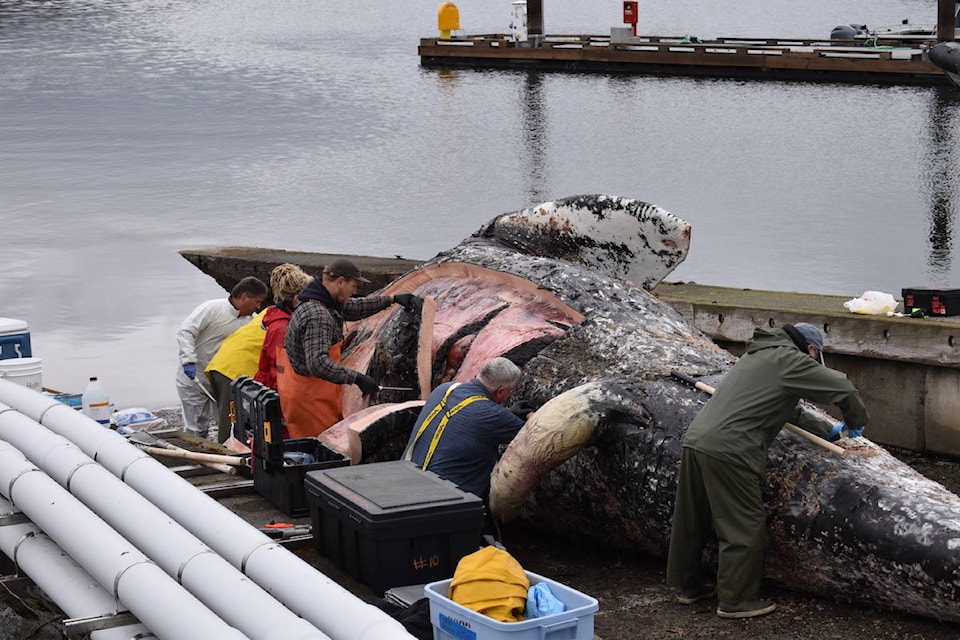Some findings from Friday’s grey whale necropsy have been released, with plastic ruled out as a cause of death.
The dead whale was spotted by a contractor on Thursday, April 4, between James and Sidney islands. The sighting was then called in using the 1-800- marine mammal hotline.
*Warning: This video contains graphic content and may not be suitable for all readers.
It was originally mistaken for a killer whale due to what appeared to be a huge dorsal fin sticking out of the water, but was actually the certain appendage of a grey whale.
The whale was towed by a Maritime Patrol Program boat around the Saanich Peninsula to the DFO base in North Saanich. There, the whale was inspected and found to be a sexually mature male, 12 metres in length and half its expected weight. The “fairly emaciated” whale was also riddled with “out of control” whale lice.
The necropsy, on Friday, April 5, was led by Dr. Stephen Raverty, Veterinary Pathologist of the BC Ministry of Agriculture, who is a specialist in whale necropsies and marine mammals.
A team of about 10 scientists and researchers from Fisheries and Oceans Canada (DFO), the Institute of Ocean Sciences (IOS) and UBC students assisted Raverty.
Paul Cottrell, DFO regional marine mammal coordinator, said it was moving to work on such a majestic creature.
ALSO READ: Scientists warn warmer and more acidic oceans threaten marine life
“It’s sobering to work on such a huge mass of animal but it is so important to get information from it, especially as we’re looking at how to minimize or mitigate threats to this species as they are listed as a Special Concern.”
Cottrell ruled out plastic as a cause of death, saying none of the substance was found in its digestive system or stomach. At this time, the cause of death remains unclear and samples have been sent for further analysis.
The scientists who receive samples will test for heavy metals, contaminants and pathogens to try establish a definitive cause of death.
“This species is susceptible to entanglements and vessel strikes,” Cottrell said, adding, “We send samples away to see if there are any broader problems with the ecosystem.”
Cottrell reports that the DFO is collaborating with Southern Californian network NOAA to see if there are any wider threats to west coast whale populations.
ALSO READ: Slaying dragons: getting inside the minds of climate change skeptics
Decaying whales produce internal gases that can build up inside a whale and even cause small explosions as they break through tissue to escape. The April 5 necropsy had long gurgling escapes of gas and a small explosion with blood spraying the arms of Raverty.
“He is the expert and we are very lucky to have him lead the necropsy,” says Cottrell. “He knows when it can be dangerous. You can get covered in blood and have pathogens blown into your mouth so we let him do it as he is so used to it.”
The scientists said that necropsies offer a huge opportunity to better understand the animals and their ecosystem. They ask that if anyone sees a marine mammal that is “injured, distressed or entangled,” they call the 24/7 marine mammal hotline 1-800-465-4336.
nick.murray@peninsulanewsreview.com
Like us on Facebook and follow us on Twitter
